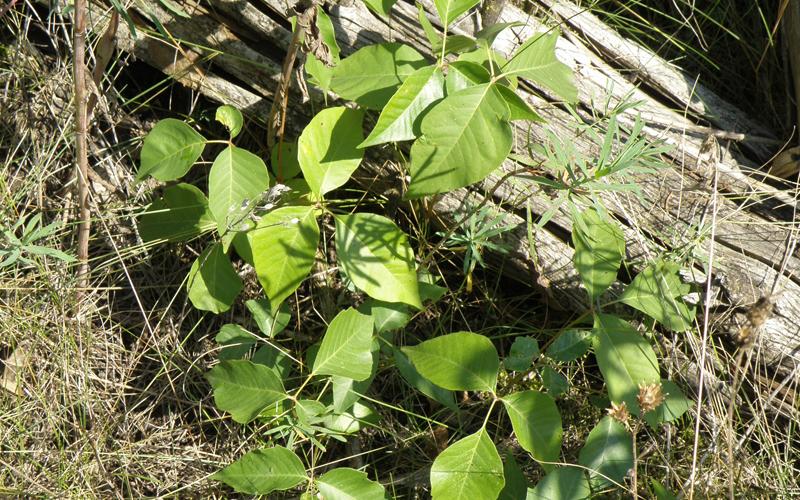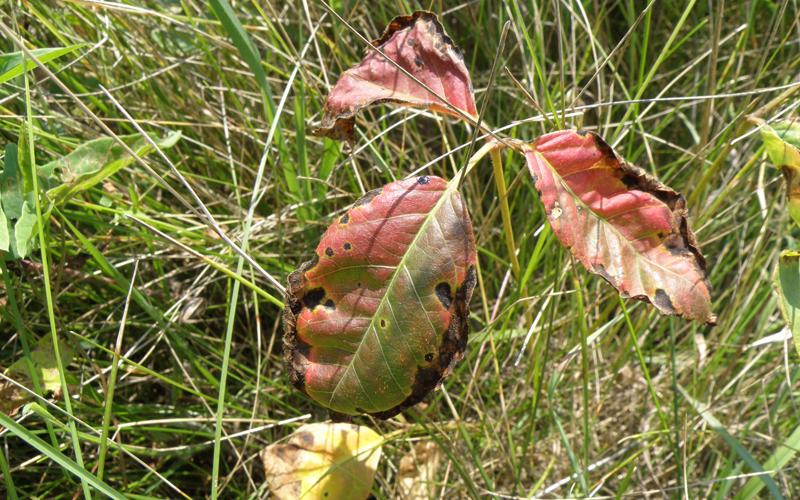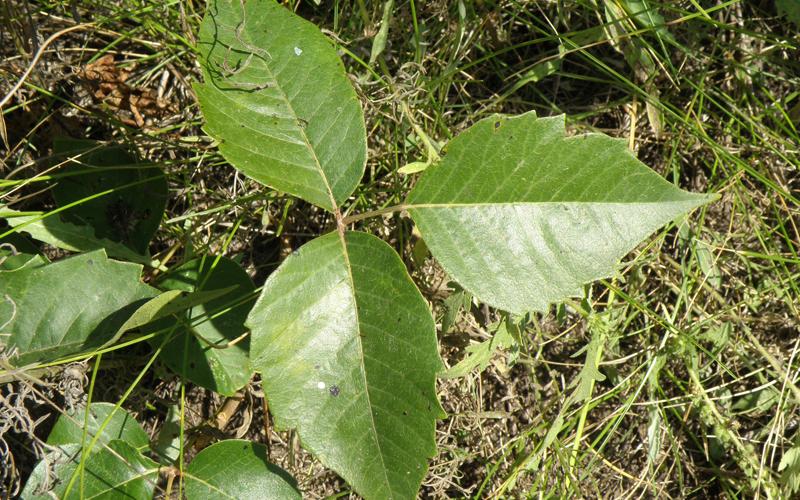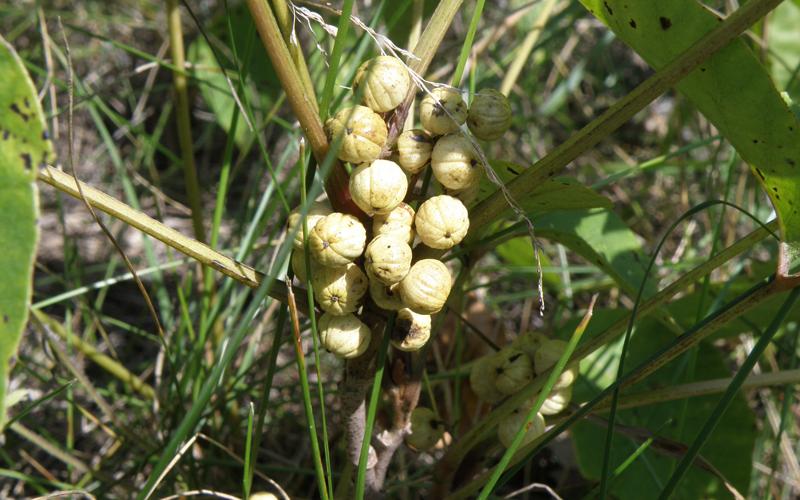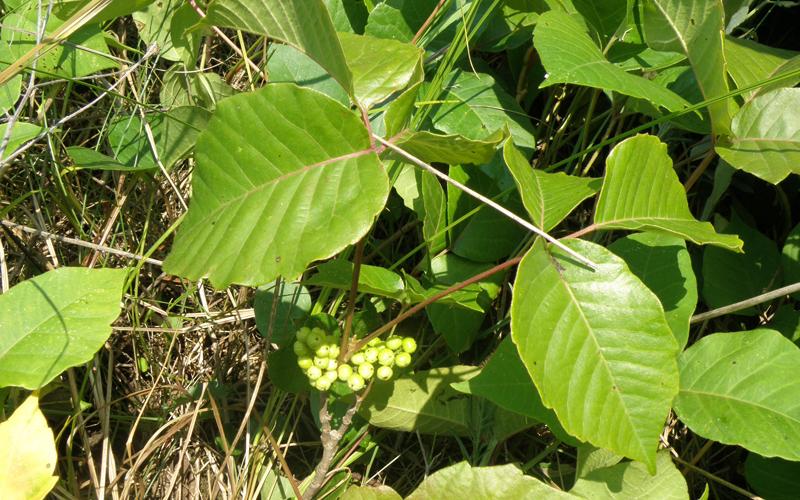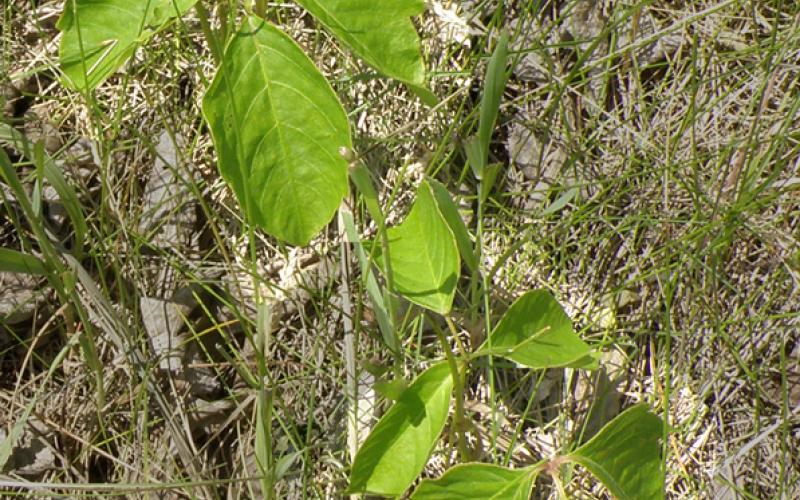Common Name: Poison Ivy
Scientific Name: Toxicodendron radicans (L.) Kuntze and T. rydbergii (Small) Green
Legal Status
Must be eradicated or controlled for public safety along rights-of-ways, trails, public accesses, business properties open to the public or on parts of lands where public access for business or commerce is granted. Must also be eradicated or controlled along property borders when requested by adjoining landowners.
Background
Poison ivy is native to Minnesota. Its range extends from Canada to South America.
Description
- A perennial plant that grows as an erect shrub or as a climbing/creeping vine.
- Has many different growth forms that determine its overall height. The shrub or prostrate growth form can be between 1- 2 feet tall and the climbing form can range from 3- 12 feet or more in length. Stems of the climbing form have small aerial roots that give the vines a "fuzzy" appearance.
- Compound leaves consist of three leaflets that tend to be egg-shaped (2- 7 inches long and 1- 4 inches wide) with pointed tips and smooth to irregularly toothed margins. Leaves are glossy-green early in the growing season and turn yellow to deep red in the fall. Leaves are also distinguished by prominent mid-veins that divide each leaflet into equal sides with smaller veins evenly spaced at a 45 degree angle to the mid-vein.
- Clusters of small yellow to greenish inconspicuous flowers form in the leaf axils during June and July. Male and female flowers are produced on separate plants.
- Small green to grayish-white berries form in the flower clusters several weeks after flowering. Berries have a waxy appearance, are subdivided into several seed chambers, and turn yellow, white or tan later in the growing season.
Habitat
Poison ivy prefers woodland and savanna habitats. It can also be found along fence rows, right-of-way (especially bordering wooded or shrub habitats), stream banks, pasture edges, and a variety of other non-cultivated habitats.
Means of spread and distribution
This plant spreads primarily by shoots arising from an extensive shallow, horizontal root system and aboveground vining. New populations are started by transportation of seeds primarily by wind, water, or animals. It is prevalent throughout Minnesota.
Impact
Poison ivy is a native species and beneficial to the landscape. Its berries serve as a food source for many wildlife species. Exposure to the toxic compound urushiol in the plant can cause severe blisters, rashes, and swelling on human skin and occasionally livestock. Poison ivy should not be allowed to contaminate hay baled for cows and horses.
Prevention and management
- ALWAYS BE CAUTIOUS! Poison ivy contains toxic compounds that can severely irritate human skin. Working in and around this plant requires caution and awareness; ALWAYS wear protective clothing and gloves. Poison ivy is native and should not be completely eradicated from a landscape. However, it should be controlled or eradicated from areas of high human, livestock, and pet traffic. DO NOT BURN poison ivy! Compounds from urushiol can be inhaled from the smoke and cause serious respiratory problems.
- Control or eradication of poison ivy by hand is not recommended. Urushiol, the toxic compound in poison ivy, can cause severe blisters, rashes, and swelling when exposed to human skin. It can also be spread through contact with the plant oil found on freshly contaminated clothing, gloves, footwear, and pet hair.
- Mowing can be done on stands where it is safe to operate equipment. However, due to its preferred habitat, mowing may not always be an option. Cutting stands several times a year to prevent or eliminate seed production, reduces the spread and overall population size. Continuous mowing for several growing season may eventually reduce the root reserves and decrease the amount of individual plants. Take care to completely rinse any equipment after operating in poison ivy.
- Various herbicides have been used successfully. If you plan to use herbicide treatments, check with your local University of Minnesota extension agent, co-op, or landscape care expert for assistance and recommendations. There are several businesses throughout the state with state-certified herbicide applicators that can be hired to perform chemical applications for poison ivy and other noxious weed species. Spring foliar and late fall cut-vine and shoot applications have been shown to produce good overall management when the proper herbicides and application techniques are used. Follow-up treatments in subsequent years are usually required to eradicate new seedlings or re-sprouts.
- Goats and sheep that have been acclimated to feed on poison ivy may be used to reduce large populations. Grazing by goats has been shown to be useful in forested areas where it is hard to use other equipment. Setting-up temporary fencing around infestations helps to keep the goats focused on a specific area and reduces non-target grazing.
Toxicity
Roots, leaves and stems contain an oily resin called urushiol which typically causes an irritating rash, blisters, or swelling when exposed to human skin, and occasionally on livestock. Burning poison ivy is very dangerous, as the smoke can contain urushiol and cause serious respiratory or other systemic health problems if inhaled.
